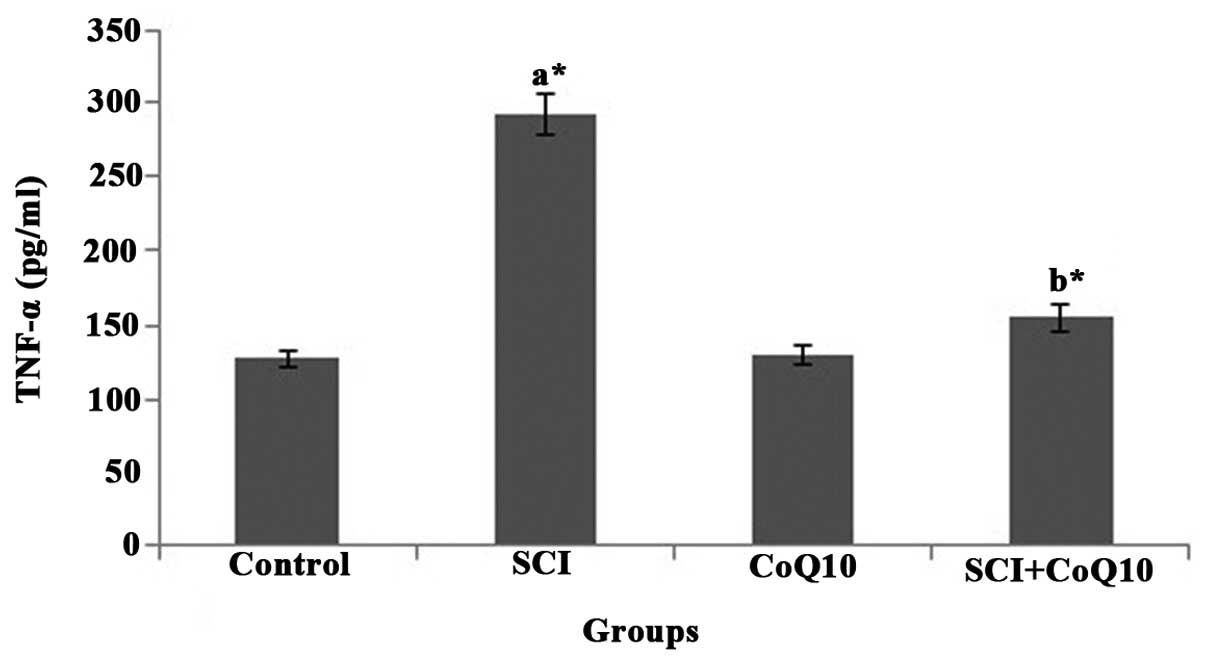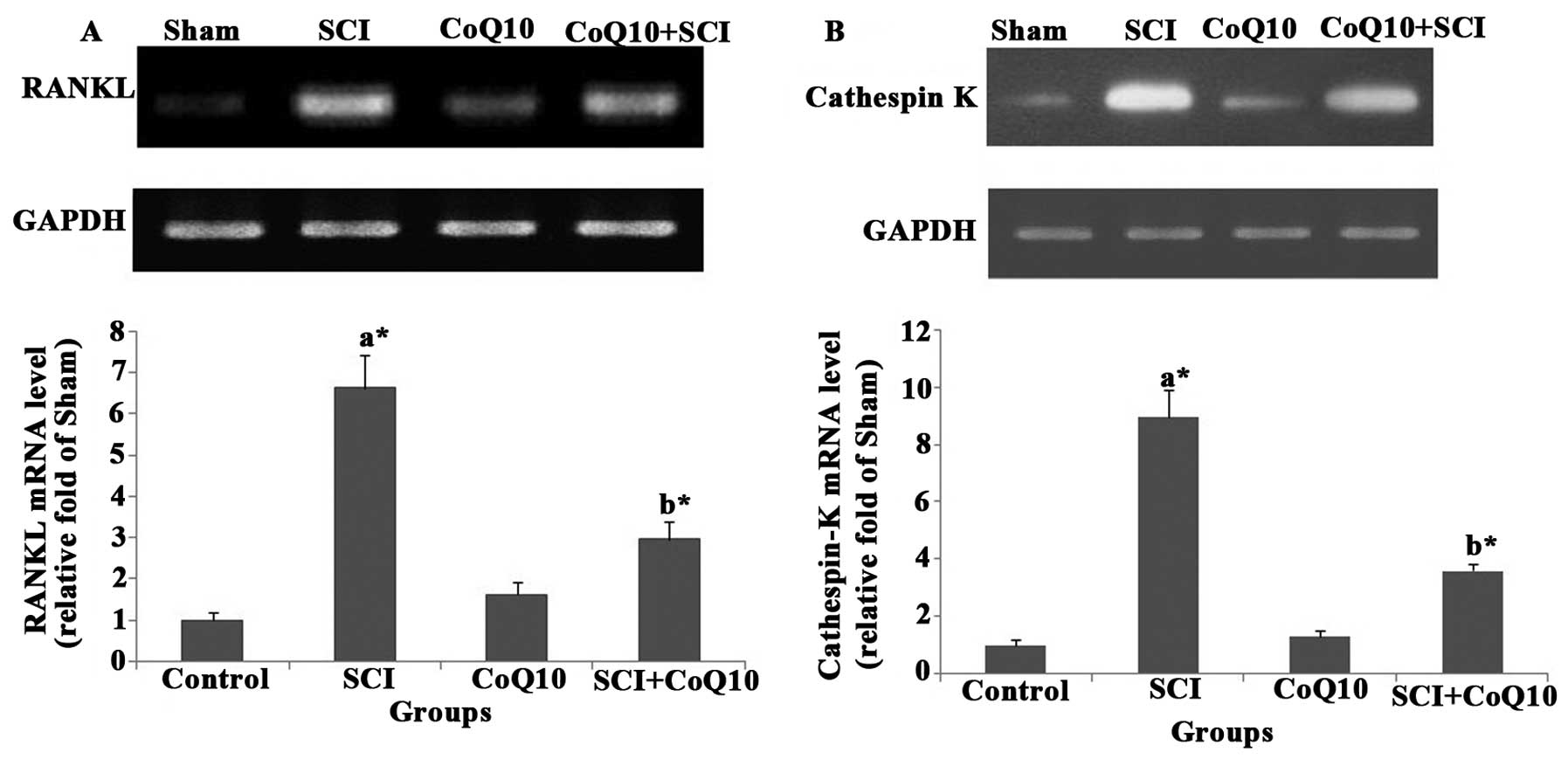|
1
|
Carlson GD and Gorden C: Current
developments in spinal cord injury research. Spine J. 2:116–128.
2002. View Article : Google Scholar
|
|
2
|
Becker D, Sadowsky CL and McDonald JW:
Restoring function after spinal cord injury. Neurologist. 9:1–15.
2003. View Article : Google Scholar : PubMed/NCBI
|
|
3
|
Bao F, Brown A, Dekaban GA, Omana V and
Weaver LC: CD11d integrin blockade reduces the systemic
inflammatory response syndrome after spinal cord injury. Exp
Neurol. 231:272–283. 2011. View Article : Google Scholar : PubMed/NCBI
|
|
4
|
Balentine JD: Pathology of experimental
spinal cord trauma I. The necrotic lesion as a function of vascular
injury. Lab Invest. 39:236–253. 1978.PubMed/NCBI
|
|
5
|
Wrathall JR, Teng YD and Choiniere D:
Amelioration of functional deficits from spinal cord trauma with
systemically administered NBQX, an antagonist of
non-N-methyl-D-aspartate receptors. Exp Neurol. 137:119–126. 1996.
View Article : Google Scholar : PubMed/NCBI
|
|
6
|
Bao F, John SM, Chen Y, Mathison RD and
Weaver LC: The tripeptide phenylalanine-(d) glutamate-(d) glycine
modulates leukocyte infiltration and oxidative damage in rat
injured spinal cord. Neuroscience. 140:1011–1022. 2006. View Article : Google Scholar : PubMed/NCBI
|
|
7
|
Liu NK, Zhang YP, Titsworth, et al: A
novel role of phospho-lipase A2 in mediating spinal cord secondary
injury. Ann Neurol. 59:606–619. 2006. View Article : Google Scholar : PubMed/NCBI
|
|
8
|
Jiang SD, Jiang LS and Dai LY: Mechanisms
of osteoporosis in spinal cord injury. Clin Endocrinol (Oxf).
65:555–565. 2006. View Article : Google Scholar
|
|
9
|
Morse L, Teng YD, Pham L, et al: Spinal
cord injury causes rapid osteoclastic resorption and growth plate
abnormalities in growing rats (SCI-induced bone loss in growing
rats). Osteoporos Int. 19:645–652. 2008. View Article : Google Scholar
|
|
10
|
Jiang SD, Jiang LS and Dai LY: Spinal cord
injury causes more damage to bone mass, bone structure,
biomechanical properties and bone metabolism than sciatic
neurectomy in young rats. Osteoporos Int. 17:1552–1561. 2006.
View Article : Google Scholar : PubMed/NCBI
|
|
11
|
Needham-Shropshire BM, Broton JG, Klose
KJ, Lebwohl N, Guest RS and Jacobs PL: Evaluation of a training
program for persons with SCI paraplegia using the Parastep 1
ambulation system, part 3: lack of effect on bone mineral density.
Arch Phys Med Rehabil. 78:799–803. 1997. View Article : Google Scholar : PubMed/NCBI
|
|
12
|
Giangregorio LM, Hicks AL, Webber CE, et
al: Body weight supported treadmill training in acute spinal cord
injury: impact on muscle and bone. Spinal Cord. 43:649–657. 2005.
View Article : Google Scholar : PubMed/NCBI
|
|
13
|
Matsumura T, Saji S, Nakamura R and
Folkers K: Evidence for enhanced treatment of periodontal disease
by therapy with coenzyme Q. Intl J Vitamin Nutr Res. 43:537–548.
1973.
|
|
14
|
Deichmann R, Lavie C and Andrews S:
Coenzyme q10 and statin-induced mitochondrial dysfunction. Ochsner
J. 10:16–21. 2010.
|
|
15
|
Kalayci M, Unal MM, Gul S, et al: Effect
of coenzyme Q10 on ischemia and neuronal damage in an experimental
traumatic brain-injury model in rats. BMC Neurosci. 12:752011.
View Article : Google Scholar : PubMed/NCBI
|
|
16
|
Kerimoğlu A, Paşaoğlu O, Kanbak G, Hanci
V, Ozdemir F and Atasoy MA: Efficiency of coenzyme Q (10) at
experimental spinal cord injury. Ulus Travma Acil Cerrahi Derg.
13:85–93. 2007.In Turkish.
|
|
17
|
Kömürcü E, Oktay M, Kaymaz B, Hatay Gölge
U, Göksel F and Nusran G: Preventive effects of coenzyme Q10
(CoQ10) on steroid-induced osteonecrosis in rats. Acta Orthop
Traumatol Turc. 48:217–222. 2014. View Article : Google Scholar : PubMed/NCBI
|
|
18
|
Moon HJ, Ko WK, Han SW, Kim DS, Hwang YS,
Park HK and Kwon IK: Antioxidants, like coenzyme Q10, selenite and
curcumin, inhibited osteoclast differentiation by suppressing
reactive oxygen species generation. Biochem Biophys Res Commun.
418:247–253. 2012. View Article : Google Scholar : PubMed/NCBI
|
|
19
|
Basso DM, Beattie MS and Bresnahan JC:
Graded histological and locomotor outcomes after spinal cord
contusion using the NYU weight-drop device versus transection. Exp
Neurol. 139:244–256. 1996. View Article : Google Scholar : PubMed/NCBI
|
|
20
|
Jo HJ and Choi M: Effects of isoflavone
supplementation on the bone mineral density of growing female rats.
Nutr Res Pract. 2:68–73. 2008. View Article : Google Scholar : PubMed/NCBI
|
|
21
|
Kakkar P, Das B and Viswanathan PN: A
modified spectrophoto-metric assay of superoxide dismutase. Indian
J Biochem Biophys. 21:130–132. 1984.PubMed/NCBI
|
|
22
|
Ohkawa H, Ohishi N and Yagi K: Assay for
lipid peroxidation in animal tissues by thiobarbituric acid
reaction. Anal Biochem. 95:351–358. 1979. View Article : Google Scholar : PubMed/NCBI
|
|
23
|
Lloyd M: Treatment of postmenopausal
osteoporosis. N Engl J Med. 338:739–746. 1998.
|
|
24
|
Rodan GA and Martin TJ: Therapeutic
approaches to bone diseases. Science. 289:1508–1514. 2000.
View Article : Google Scholar : PubMed/NCBI
|
|
25
|
Rachner TD, Khosla S and Hofbauer LC:
Osteoporosis: now and the future. Lancet. 377:1276–1287. 2011.
View Article : Google Scholar : PubMed/NCBI
|
|
26
|
Jiang SD, Jiang LS and Dai LY: Changes in
bone mass, bone structure, bone biomechanical properties and bone
metabolism after spinal cord injury: a 6-month longitudinal study
in growing rats. Calcif Tissue Int. 80:167–175. 2007. View Article : Google Scholar : PubMed/NCBI
|
|
27
|
Liu D, Zhao CQ, Li H, Jiang SD, Jiang LS
and Dai LY: Effects of spinal cord injury and hindlimb
immobilization on sublesional and supralesional bones in young
growing rats. Bone. 43:119–125. 2008. View Article : Google Scholar : PubMed/NCBI
|
|
28
|
Giangregorio LM, Craven BC and Webber CE:
Musculoskeletal changes in women with spinal cord injury: a twin
study. J Clin Densitom. 8:347–351. 2005. View Article : Google Scholar : PubMed/NCBI
|
|
29
|
Schmid A, Huonker M, Stahl F, et al: Free
plasma catecholamines in spinal cord injured persons with different
injury levels at rest and during exercise. J Auton Nerv Syst.
68:96–100. 1998. View Article : Google Scholar : PubMed/NCBI
|
|
30
|
Vaziri ND, Pandian MR, Segal JL, Winer RL,
Eltorai I and Brunnemann S: Vitamin D, parathormone and calcitonin
profiles in persons with long-standing spinal cord injury. Arch
Phys Med Rehabil. 75:766–769. 1994.PubMed/NCBI
|
|
31
|
Morse LR, Xu Y, Solomon B, et al: Severe
spinal cord injury causes immediate multi-cellular dysfunction at
the chondro-osseous junction. Transl Stroke Res. 2:643–650. 2011.
View Article : Google Scholar
|
|
32
|
Pietschmann P, Pils P, Woloszczuk W, Maerk
R, Lessan D and Stipicic J: Increased serum osteocalcin levels in
patients with paraplegia. Paraplegia. 30:204–209. 1992. View Article : Google Scholar : PubMed/NCBI
|
|
33
|
Morse L, Teng YD, Pham L, et al: Spinal
cord injury causes rapid osteoclastic resorption and growth plate
abnormalities in growing rats (SCI-induced bone loss in growing
rats). Osteoporos Int. 19:645–652. 2008. View Article : Google Scholar
|
|
34
|
Majumdar S, Kothari M, Augat P, et al:
High-resolution magnetic resonance imaging: three-dimensional
trabecular bone architecture and biomechanical properties. Bone.
22:445–454. 1998. View Article : Google Scholar : PubMed/NCBI
|
|
35
|
Jia Z, Zhu H, Li J, Wang X, Misra H and Li
Y: Oxidative stress in spinal cord injury and antioxidant-based
intervention. Spinal Cord. 50:264–274. 2012. View Article : Google Scholar
|
|
36
|
Sun Y, Shuang F, Chen DM and Zhou RB:
Treatment of hydrogen molecule abates oxidative stress and
alleviates bone loss induced by modeled microgravity in rats.
Osteoporos Int. 24:969–978. 2013. View Article : Google Scholar
|
|
37
|
Fouad AA, Al-Sultan AI, Refaie SM and
Yacoubi MT: Coenzyme Q10 treatment ameliorates acute cisplatin
nephrotoxicity in mice. Toxicology. 274:49–56. 2010. View Article : Google Scholar : PubMed/NCBI
|
|
38
|
Demulder A, Guns M, Ismail A, Wilmet E,
Fondu P and Bergmann P: Increased osteoclast-like cells formation
in long-term bone marrow cultures from patients with a spinal cord
injury. Calcif Tissue Int. 63:396–400. 1998. View Article : Google Scholar : PubMed/NCBI
|
|
39
|
Lee J, Hong YS, Jeong JH, et al: Coenzyme
Q10 ameliorates pain and cartilage degradation in a rat model of
osteoarthritis by regulating nitric oxide and inflammatory
cytokines. PLoS One. 8:e693622013. View Article : Google Scholar : PubMed/NCBI
|
|
40
|
Jin HJ, Xue Y, Chen G and Wu ZY: Effect of
coenzyme Q10 on the expression of tumor necrosis factor-α and
interleukin-10 in gingival tissue of experimental periodontitis in
rats. Zhonghua Kou Qiang Yi Xue Za Zhi. 48:660–663. 2013.In
Chinese.
|
|
41
|
Fouad AA and Jresat I: Hepatoprotective
effect of coenzyme Q10 in rats with acetaminophen toxicity. Environ
Toxicol Pharmacol. 33:158–167. 2012. View Article : Google Scholar : PubMed/NCBI
|
|
42
|
Lacey DL, Timms E, Tan HL, et al:
Osteoprotegerin ligand is a cytokine that regulates osteoclast
differentiation and activation. Cell. 93:165–176. 1998. View Article : Google Scholar : PubMed/NCBI
|
|
43
|
Hsu H, Lacey DL, Dunstan CR, et al: Tumor
necrosis factor receptor family member RANK mediates osteoclast
differentiation and activation induced by osteoprotegerin ligand.
Proc Natl Acad Sci USA. 96:3540–3545. 1999. View Article : Google Scholar : PubMed/NCBI
|
|
44
|
Simonet WS, Lacey DL, Dunstan CR, et al:
Osteoprotegerin: a novel secreted protein involved in the
regulation of bone density. Cell. 89:309–319. 1997. View Article : Google Scholar : PubMed/NCBI
|
|
45
|
Moon HJ, Ko WK, Jung MS, et al: Coenzyme
q10 regulates osteoclast and osteoblast differentiation. J Food
Sci. 78:H785–H891. 2013. View Article : Google Scholar : PubMed/NCBI
|
|
46
|
Brömme D and Okamoto K: Human cathepsin
O2, a novel cysteine protease highly expressed in
osteoclastomas and ovary molecular cloning, sequencing and tissue
distribution. Biol Chem Hoppe Seyler. 376:379–384. 1995. View Article : Google Scholar
|
|
47
|
Ho N, Punturieri A, Wilkin D, et al:
Mutations of CTSK result in pycnodysostosis via a reduction in
cathepsin K protein. J Bone Miner Res. 14:1649–1653. 1999.
View Article : Google Scholar : PubMed/NCBI
|
|
48
|
Johnson MR, Polymeropoulos MH, Vos HL,
Oetiz De Luna RI and Francomano CA: A nonsense mutation in the
cathepsin K gene observed in a family with pycnodysostosis. Genome
Res. 6:1050–1055. 1996. View Article : Google Scholar : PubMed/NCBI
|
|
49
|
Saftig P, Hunziker E, Wehmeyer O, et al:
Impaired osteoclastic bone resorption leads to osteopetrosis in
cathepsin-K-deficient mice. Proc Natl Acad Sci USA. 95:13453–13458.
1998. View Article : Google Scholar : PubMed/NCBI
|
|
50
|
Pennypacker BL, Oballa RM, Levesque S,
Kimmel DB and Duong le T: Cathepsin K inhibitors increase distal
femoral bone mineral density in rapidly growing rabbits. BMC
Musculoskelet Disord. 14:3442013. View Article : Google Scholar : PubMed/NCBI
|
|
51
|
Xiao G, Jiang D, Ge C, et al: Cooperative
interactions between activating transcription factor 4 and
Runx2/Cbfa1 stimulate osteoblast-specific osteocalcin gene
expression. J Biol Chem. 280:30689–30696. 2005. View Article : Google Scholar : PubMed/NCBI
|
|
52
|
Liu W, Toyosawa S, Furuichi T, et al:
Overexpression of Cbfa1 in osteoblasts inhibits osteoblast
maturation and causes osteopenia with multiple fractures. J Cell
Biol. 155:157–166. 2001. View Article : Google Scholar : PubMed/NCBI
|
















